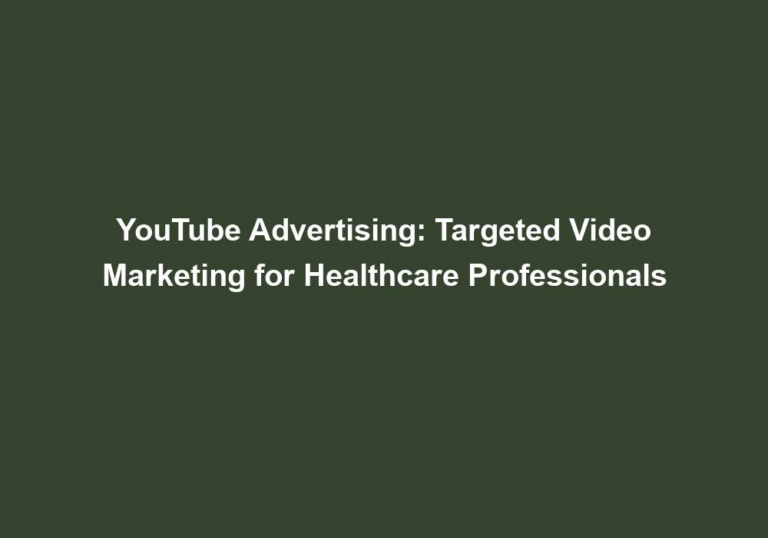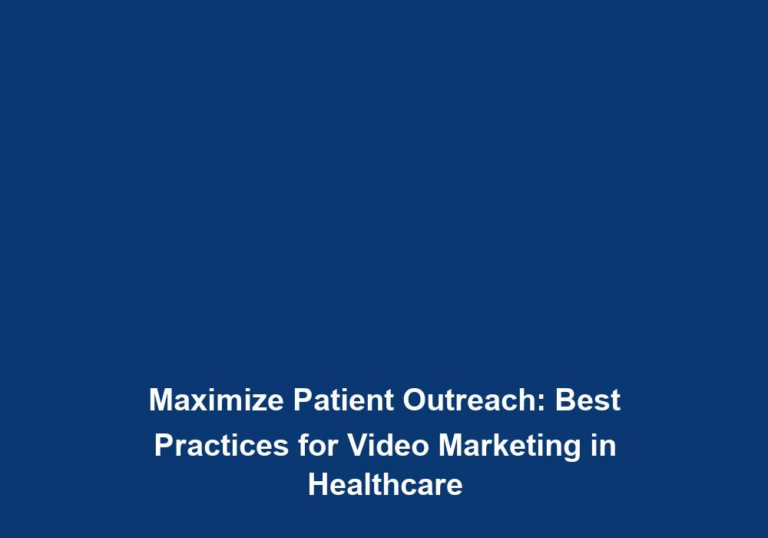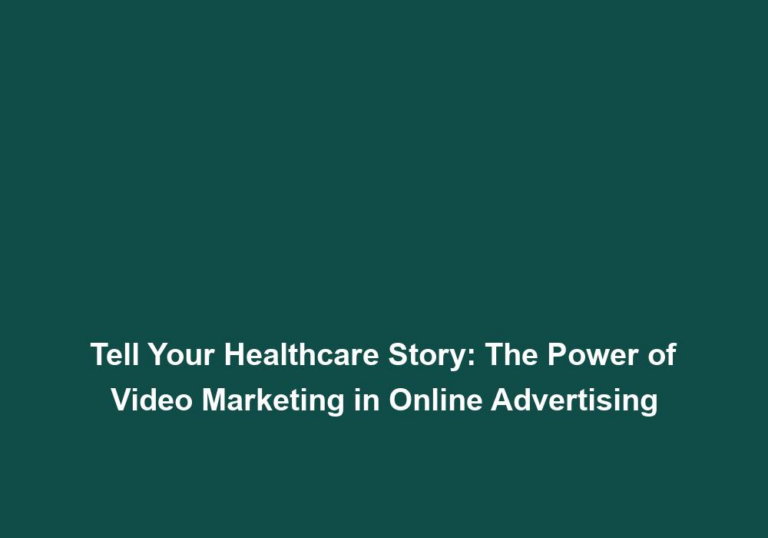Spreading Awareness: The Role of Educational Medical Videos in Video Marketing
In today’s digital age, video marketing has become a powerful tool for businesses across various industries, including the healthcare sector. One particular type of video content that has gained significant traction and proven to be highly effective is educational medical videos. These videos play a crucial role in spreading awareness about medical conditions, treatments, and preventive measures. In this article, we will explore the importance of educational medical videos in video marketing and why they are an essential component of any successful marketing strategy.
The Power of Visual Content
As human beings, we are naturally drawn to visual content. Our brains are wired to process visuals more efficiently than text, making videos an ideal medium for conveying complex medical information. Educational medical videos combine visuals, audio, and often animations to present information in an engaging and easily digestible manner. By leveraging the power of visual storytelling, these videos captivate viewers and effectively deliver key messages.
Educational medical videos have the ability to engage viewers on a deeper level by appealing to their visual senses. Through carefully crafted visuals, these videos enhance the understanding and retention of medical information. For example, by incorporating animations and diagrams, educational medical videos can illustrate the inner workings of the human body, making it easier for viewers to grasp complex concepts.
Furthermore, visuals can evoke emotions and create a more memorable experience for viewers. By incorporating emotional storytelling techniques, educational medical videos can stir empathy, compassion, and motivation in the audience. This emotional connection can lead to increased engagement and a stronger impact on viewers’ behavior and decision-making.
In addition to the visual appeal, educational medical videos can also benefit from incorporating audio elements. By using clear and concise narration, these videos can further enhance the delivery of information. The combination of visuals and audio creates a multi-sensory experience that not only captures viewers’ attention but also improves their understanding and retention of the content.
Breaking Down Complex Medical Concepts
Medical information can often be overwhelming and difficult to understand, especially for individuals without a medical background. Educational medical videos bridge this gap by breaking down complex concepts into simplified terms that are easier for the general public to understand. Through the use of visuals, diagrams, and animations, these videos can demonstrate medical procedures, explain the mechanism of action of drugs, or illustrate the progression of a disease. By presenting information in a clear and concise manner, educational medical videos empower viewers to make informed decisions about their health.
One effective strategy in breaking down complex medical concepts is to use storytelling techniques. By presenting information in the form of a story, educational medical videos can engage viewers and make the content more relatable. For example, by following the journey of a patient who successfully manages their condition, viewers can better understand the steps involved and feel inspired to take control of their own health.
In addition to storytelling, educational medical videos can also benefit from incorporating real-life examples and case studies. By showcasing real patients and their experiences, these videos provide a practical context for viewers to relate to. This approach not only enhances understanding but also helps viewers see the relevance and applicability of the information presented.
Furthermore, educational medical videos can utilize visual aids such as charts, graphs, and infographics to simplify complex data and statistics. These visual representations can make it easier for viewers to grasp the significance and implications of the information, enabling them to make more informed decisions about their healthcare.
Enhancing Patient Education and Empowerment
One of the primary benefits of educational medical videos is their ability to educate and empower patients. Patients often face challenging decisions regarding their healthcare, and having access to reliable information is crucial. These videos serve as valuable educational resources, ensuring that patients have a comprehensive understanding of their medical conditions, treatment options, and potential outcomes. By providing patients with the knowledge they need, educational medical videos empower them to actively participate in their healthcare journey and make informed decisions alongside their healthcare providers.
To enhance patient education and empowerment, educational medical videos can incorporate interactive elements. For example, quizzes or interactive diagrams can be included to test viewers’ understanding and reinforce key concepts. This interactive approach encourages active engagement and helps viewers retain the information more effectively.
Furthermore, educational medical videos can provide practical tips and guidance on managing medical conditions. By offering actionable advice, these videos empower patients to take control of their health and implement necessary lifestyle changes. For example, a video on diabetes management can include tips on healthy eating, exercise, and blood sugar monitoring, giving patients the tools they need to make positive changes in their daily lives.
Moreover, educational medical videos can address common misconceptions and debunk myths surrounding medical conditions. By providing accurate and evidence-based information, these videos help patients make informed decisions and avoid potentially harmful practices. This knowledge empowers patients to advocate for themselves and ensures that they receive appropriate care and treatment.
Spreading Awareness and Reaching a Wider Audience
In the realm of video marketing, the ultimate goal is to reach a wide audience and spread awareness about a particular brand, product, or cause. Educational medical videos are an excellent tool for achieving this objective in the healthcare industry. By creating informative and shareable content, healthcare organizations can reach a broader audience beyond their immediate patient base. These videos can be easily shared on social media platforms, websites, and other digital channels, allowing them to spread like wildfire and generate significant brand exposure.
To maximize the reach and impact of educational medical videos, healthcare organizations can employ various strategies. First and foremost, creating content that is relevant and addresses common health concerns can attract a wider audience. By focusing on topics that resonate with the general public, healthcare organizations can capture the interest of individuals who may not have an immediate need for medical services but are still interested in maintaining their health and well-being.
Additionally, healthcare organizations can collaborate with influencers or experts in the field to promote their educational medical videos. By leveraging the existing audience and credibility of these individuals, the videos can reach a larger and more diverse audience. This strategy can also help establish the healthcare organization as a reputable source of information and expertise in the industry.
Furthermore, healthcare organizations can encourage viewers to share the videos with their networks by incorporating social sharing buttons and calls to action within the videos. By making it easy for viewers to spread the content, healthcare organizations can amplify the reach and impact of their educational medical videos.
Improving Patient-Doctor Communication
Effective communication is the cornerstone of any successful doctor-patient relationship. However, medical jargon and complex terminology often hinder effective communication between healthcare professionals and patients. Educational medical videos serve as a bridge, facilitating better understanding and communication between doctors and patients. By visually explaining medical concepts, procedures, and treatment options, these videos enable patients to have more meaningful conversations with their doctors. This enhanced communication fosters trust, improves patient satisfaction, and ultimately leads to better healthcare outcomes.
One way educational medical videos improve patient-doctor communication is by providing patients with a visual reference that they can easily understand and refer back to. For example, a video demonstrating the correct way to administer medication can help patients follow the instructions accurately, reducing the likelihood of errors or misunderstandings.
Moreover, educational medical videos can help patients prepare for medical appointments by providing them with a better understanding of their condition and treatment options. This knowledge empowers patients to ask relevant questions, express their concerns, and actively participate in the decision-making process. By fostering a collaborative approach to healthcare, educational medical videos contribute to a more patient-centered and holistic care experience.
Additionally, healthcare professionals can use educational medical videos as a tool to educate their patients during consultations. By incorporating videos into their practice, doctors can supplement their verbal explanations with visual aids, reinforcing key points and ensuring that patients fully grasp the information. This approach not only enhances understanding but also saves valuable consultation time, allowing doctors to address other important aspects of patient care.
Engaging and Retaining Online Audiences
In today’s digital landscape, attention spans are shorter than ever. To keep online audiences engaged, businesses must deliver content that is captivating and compelling. Educational medical videos are an ideal solution for healthcare organizations aiming to engage and retain their online audiences. These videos are not only educational but also entertaining, making viewers more likely to watch them in their entirety. By consistently producing high-quality educational videos, healthcare organizations can build a loyal following, establish themselves as thought leaders, and solidify their online presence.
To ensure maximum engagement and retention, educational medical videos can incorporate various storytelling techniques. For example, using real-life patient testimonials or success stories can create an emotional connection with the audience. By highlighting the human aspect of healthcare, these videos can resonate with viewers on a deeper level and encourage them to share the content with others.
Furthermore, educational medical videos can leverage the power of storytelling by presenting information in a narrative format. By structuring the video as a story with a beginning, middle, and end, healthcare organizations can create a sense of anticipation and hold viewers’ attention throughout. This approach can be particularly effective in videos that address long-term health conditions or treatment journeys, as viewers can follow the progress and outcomes of the story.
In addition to storytelling, educational medical videos can benefit from incorporating interactive elements. For example, quizzes or polls can be included to engage viewers and encourage active participation. This interactive approach not only enhances the viewing experience but also creates a sense of interactivity and personalization, making the content more memorable.
Best Practices for Creating Educational Medical Videos
While educational medical videos offer numerous benefits, it is essential to adhere to best practices to maximize their effectiveness. Here are some key considerations when creating these videos:
-
Accuracy and Credibility: Ensure that all information presented in the videos is accurate, up-to-date, and supported by credible sources. Misinformation can be detrimental to both patients and the reputation of the healthcare organization.
-
Simplicity and Clarity: Use plain language and avoid medical jargon as much as possible. The goal is to make the content accessible to a broad audience, regardless of their medical knowledge.
-
Visual Appeal: Pay attention to the video’s visual elements, such as graphics, animations, and overall design. A visually appealing video is more likely to capture and retain viewers’ attention.
-
Optimize for SEO: Implement proper search engine optimization techniques to ensure that the videos rank well in search engine results. This will increase the likelihood of reaching a wider audience and driving more traffic to the healthcare organization’s website.
-
Call to Action: Include a clear call to action at the end of the video, prompting viewers to engage further, such as visiting the organization’s website, scheduling an appointment, or subscribing to a newsletter.
By following these best practices, healthcare organizations can create impactful educational medical videos that resonate with their target audience and drive meaningful engagement.
In conclusion, educational medical videos play an integral role in video marketing strategies for healthcare organizations. Through their ability to simplify complex medical concepts, enhance patient education, and spread awareness, these videos contribute to improved patient outcomes, increased brand exposure, and enhanced doctor-patient communication. By investing in high-quality educational medical videos, healthcare organizations can effectively leverage the power of video marketing to educate, engage, and empower their target audience.






